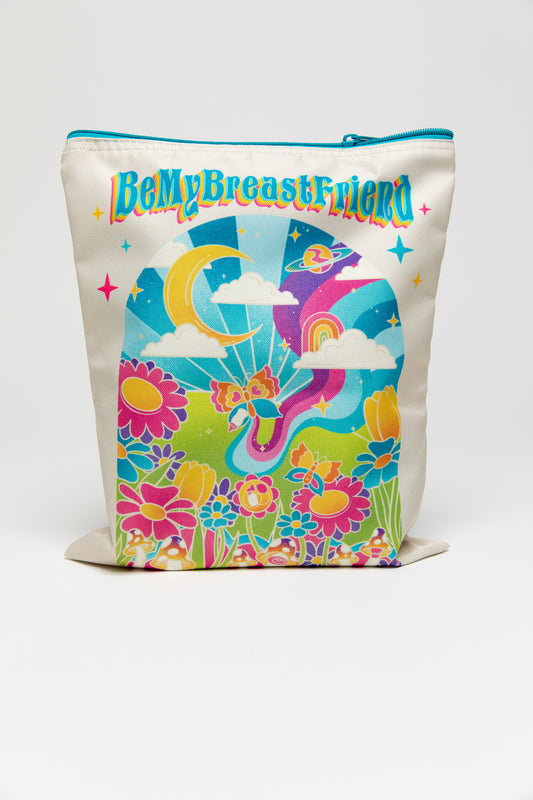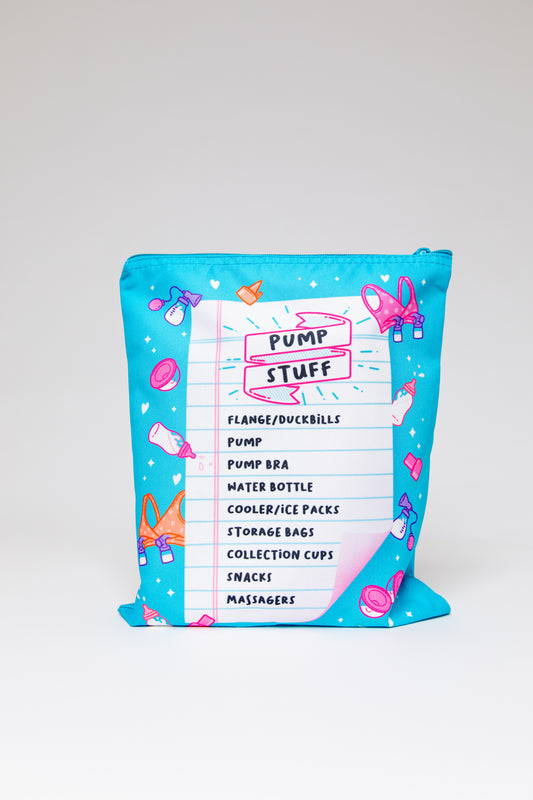
Maybe you're reading this blog at 4am as you're feeding your newborn and changing your milk-stained pajamas for the third time since going to bed. No, you aren't always going to leak breast milk all over everything or become uncomfortable if you go one minute past three hours between feeding or pumping sessions. So, the question that plagues breastfeeding moms everywhere: "Has my milk supply regulated yet?" I’m here to tell you what’s up with milk regulation—in plain, blunt, no-nonsense terms.
What's Happening to my Body?
Let’s start with what’s actually going on inside your body as you become a milk-making machine following birth.
When you were pregnant, your placenta was the MVP. It kept your baby fed, happy, and thriving for nine months while also producing sky-high levels of progesterone. But here’s the kicker—that same progesterone suppressed prolactin, the hormone responsible for breastmilk production.
Then comes delivery. Once your placenta is delivered, your hormones do a little dance. Progesterone drops, prolactin spikes, and BAM—full milk production becomes possible. During those early weeks of postpartum life, prolactin (think milk-making hormones) controls your milk supply first and foremost. Supply and demand also play some role, but they don't really take over until many weeks from now. Prolactin’s role during this time period can lead to frequent breast engorgement or an oversupply of milk. Have full breasts and a waterfall-in-your-bra situation? I know the feeling! You're not going crazy, it will not always be this intense!
During at least the first month postpartum, it’s critical to feed your baby on demand or pump frequently—according to common suggestion, 8 to 12 pump sessions a day, to be exact-- to help you begin to to establish your supply. I will admit I go against the grain on this advice, if you're able to pump 7 to 8 times a day, you are doing great! This is your body’s way of figuring out how much breast milk your baby actually needs. Your body is smart enough to know that baby's needs may change a little here and there during the beginning stages of breastfeeding, so it wants to make sure there's plenty to go around. Thanks, hormones!
When Will My Supply Become More Regular?
At around 8 to 12 weeks postpartum, prolactin and supply-and-demand do a little switcheroo. Prolactin moves to the backburner, and supply-and-demand is in the driver's seat. Translation: your milk supply now adapts to your baby’s appetite and demand, not just hormonal fluctuations.
Now, prolactin is still hanging out. In fact, it’s essential for milk production. But, now your body won’t just make milk for the heck of it. If you don’t demand milk by nursing or pumping frequently, prolactin won’t magically step in to save the day. It'll take some hard work to change your supply after the 8-12 week mark. It's not impossible though!
How Will I know My Supply Has Regulated?
Breast milk supply regulation seems to start to take place at the same time you may be feeling a bit more like yourself. While you adjust to your new life with baby, your boobs also become more manageable, thank goodness.

Here are 4 telltale signs to watch for if you’re wondering, "Has my milk supply regulated?"
1. A Decrease in Supply
Don’t panic! It’s normal for your supply to dip a bit once regulation happens, and it isn't a problem for most women. Your body is no longer in overachiever mode—it’s simply keeping up with the needs of your breastfed baby.
2. Breasts No Longer Feel Engorged
Remember those rock-hard, about-to-explode breasts from the first couple of weeks? Yeah, those should be a thing of the past once regulation sets in. Your breasts might feel softer and less “full” between feedings, and that’s a good thing.
3. Breasts Feel Softer or Empty
Even when your breasts feel soft or empty, they’re still producing plenty of milk! Your body is just more efficient now. Milk removal is consistent, and you’re not a ticking milk bomb anymore.
4. Leaking Less Frequently
Perhaps the best part of supply regulation - you're not leaking through all of your shirts! If you were leaking breast milk like a busted fire hydrant in the early days, you’ll likely notice less leaking once regulation kicks in. Your body has figured out how to produce just the amount of milk needed, and it’s not wasting much excess. However, many women will still experience small amounts of leakage for the next few months.
Still Leaking?
Speaking of leaking, if you are soaking through every bra and shirt, here are some items from my Amazon storefront you may want to try out!
- Lasinoh Stay Dry Disposable Nursing Pads
- Kindred Bravely Organic Reusable Nursing Pads
- Elvie Catch Discreet Collection Cups
- Boob Trove Catcher, my personal favorite!
What if My Milk Supply Drops Too Much?

1. Increase Pumping Sessions
Pump more often—even for short sessions. Aim to add in an extra pumping session or two throughout the day and see if that helps!
2. Power Pump
Power pumping mimics cluster feeding and can help tell your body, “Hey, we need more milk here!” Once each day until you see a difference (about one week), try pumping for 20 minutes, resting for 10, pumping for 10 more minutes, resting for 10, and pumping one final time for 10 minutes.
3. Pump After Nursing
If you’re nursing, try pumping for 10 to 15 minutes after your baby nurses once or twice a day for a week or so. It signals to your body that more milk is needed.
4. See a Lactation Consultant
If you're becoming stressed about your supply, it may be a good idea to schedule a visit with a lactation consultant. They can assess the situation and help you identify an effective way to increase your supply. Be prepared to answer questions about your baby feeding patterns, dirty diapers, and your general daily volume of milk.
Why a Pumping Schedule Matters
If you’re exclusively pumping, you’re not latching baby to the breast every time they show hunger cues. So, supply regulation is going to look a bit different for you than it may if you were exclusively nursing. Your pump is the stand-in for signaling milk demand. This is why it’s important to determine a consistent pumping schedule to encourage supply regulation.
During the early weeks, aim for at least '8-12' sessions per day to mimic baby's frequent feeding. Once your supply is well-established and regulated, you can start spacing sessions further apart—as long as you’re still producing enough milk to satisfy your baby. Do you have questions about how to adjust your pumping schedule as your baby begins to sleep longer stretches at night? For more information, check out my blog post about Pumping at Night.
Consistency is truly the key to regulating your breast milk production. Frequently skipping sessions, especially in your first few weeks postpartum, can send your body signals that less milk is needed, leading to a low milk supply. Plus, you put yourself at risk for clogged ducts or mastitis.
Boosting Your Breast Health: Supplements & Foods
While frequent and efficient milk removal is the recipe for supply, you can also support your breast health with galactagogues (a fancy word for milk-boosting foods or supplements). Ultimately, your overall nutrition will support your lactation journey, not a bag of Oreos or Blue Gatorade! Here are a few options to consider:
- Oatmeal: The breakfast of champions—and breastfeeding moms.
- Supplements: Read my blog here to figure out how you can support your breastfeeding experience with supplements. Chat with your healthcare provider before making any changes to your current medications.
- Hydration & Nutrition: You can’t run a milk factory or keep yourself energized on an empty tank. Drink plenty of water and eat nutrient-dense foods to fuel your body.
Final Thoughts: Trust Your Body
Milk supply regulation can feel weird and even a little scary at first—it’s totally normal to wonder if you're body is doing everything it should be doing to meet your baby's needs. If you notice softer breasts, less leaking, and a slight dip in supply, take a deep breath. These are all signs of a healthy milk supply.
And if your supply dips a little too much? Don’t stress. Just work on demanding more milk with frequent pumping sessions, power pumping, or nursing.
While today's question may be, "Has my milk supply regulated?", before you know it you'll be asking, "Where did the time go?" while planning your baby's first birthday party. Time flies, mama. Try to treasure every moment!






